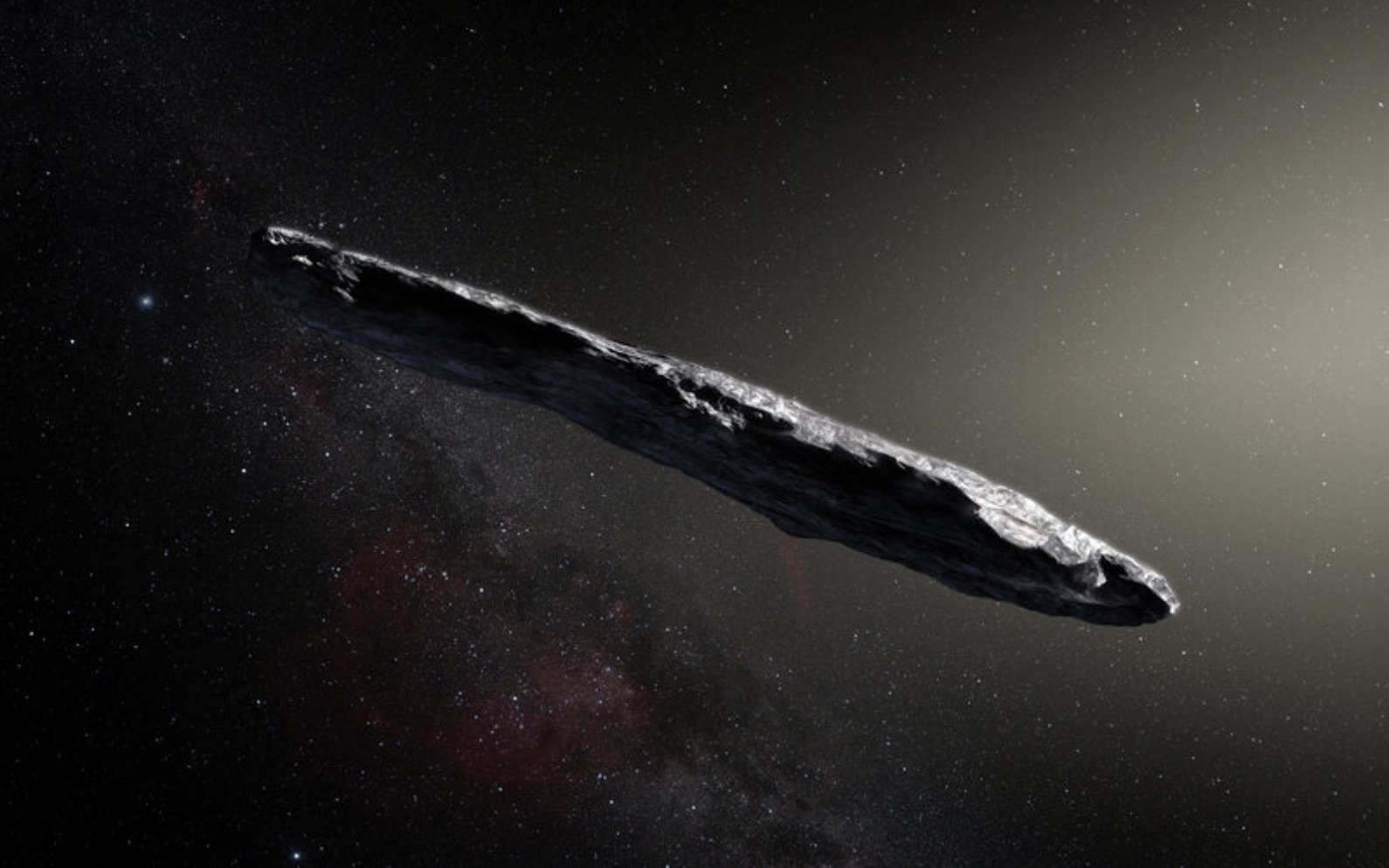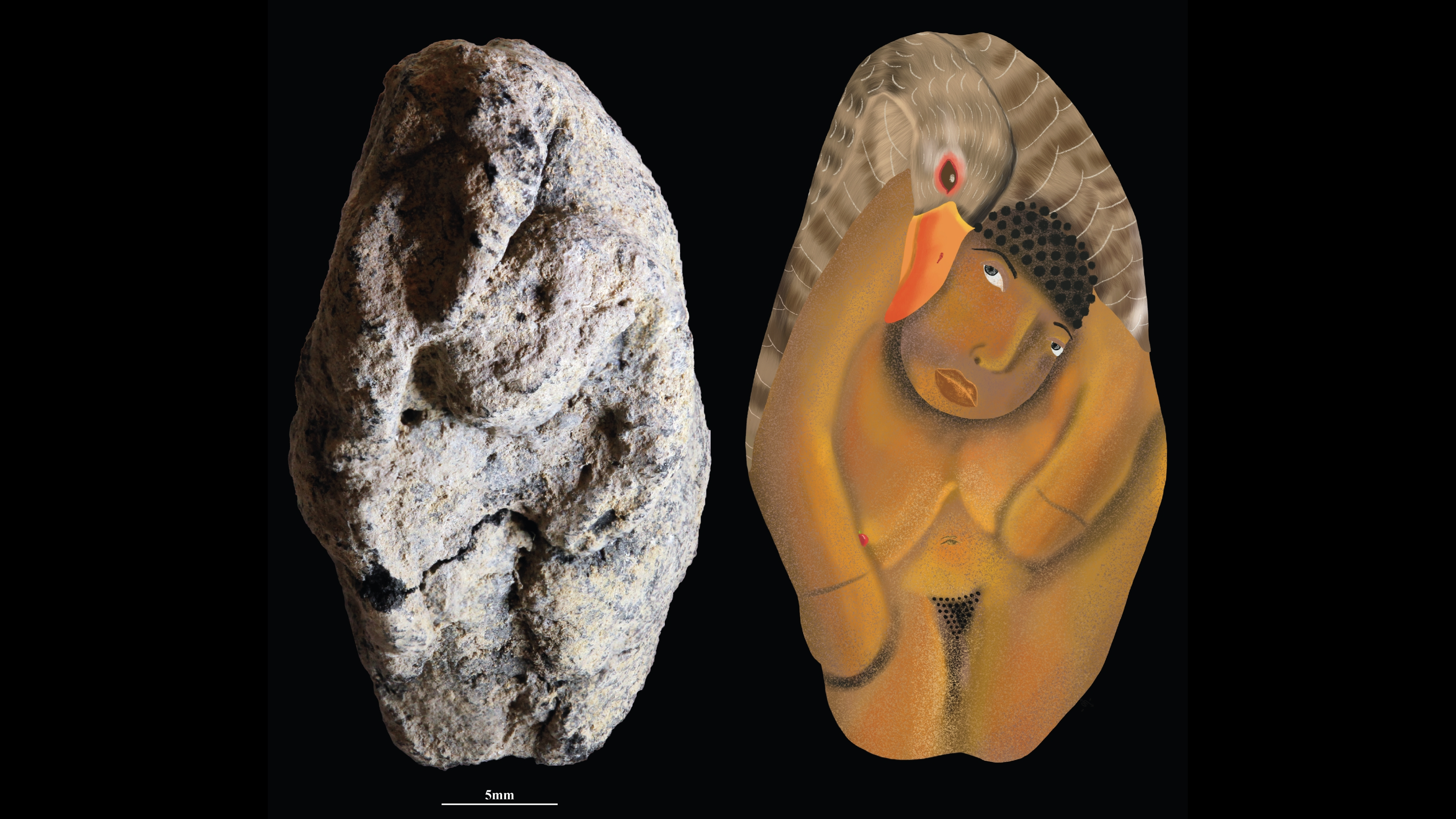Why Was 'Oumuamua So Weird? New Research Tries to Track Its Origins.

In 2017, astronomers were startled to find a peculiar object in the solar system.
A combination of this object's incredible speed and ridiculous inclination revealed that it did not belong to us. Instead, this object was a visitor from some distant, unknown solar system altogether. Astronomers eventually named it 'Oumuamua, which is a Hawaiian word that roughly translates to "the scout." By the time we spotted the foreigner, it was already making its way back out to the interstellar depths from which it came.
Related: Interstellar Comet: Here's Why It's Got Scientists So Pumped Up
Obviously, some chain of unfortunate events led to the ejection of 'Oumuamua from its home system. But what could possibly cause such a catastrophe?
Now, astronomers have hypothesized that something like 'Oumuamua can come from a still-forming system, and a population of giant planets can have just the right gravitational effects to spread pieces of debris across the galaxy.
The interstellar interloper
To be perfectly frank, 'Oumuamua is absolutely nothing like anything else in the solar system. Leaving aside the characteristics of its orbit, which firmly pin it down as the interstellar interloper it truly is, the thing is just a strange rock all together.
'Oumuamua is only a few hundred feet long, but very thin, shaped something like a giant space cigar. The object has a dull red color to it, reminiscent of the objects found in the distant outskirts of our own solar system, like Pluto.
Get the world’s most fascinating discoveries delivered straight to your inbox.
'Oumuamua should, by all rights, be a comet. After all, distant comets are only loosely attached to their own stars and are the best candidates for being ejected, scattering to the four corners of the galaxy. And yet, 'Oumuamua lacks the clear signs of cometary activity. No tail. No outgassing. Even though it acts like a comet, it looks like an asteroid.
And the biggest puzzle regarding 'Oumuamua is that we even saw it at all. Consider the scale of time and space at work in a galaxy. Stars live and die over the course of millions or billions of years. The formation of a system takes hundreds of millions of years. It takes tens of thousands of years for even the fastest-moving objects to hop from star to star.
In contrast, we've only been searching the heavens with telescopes for about 400 years. That's basically nothing; a thin sliver of time to monitor the cosmos. And it's only within the past few decades — and even a few years — that we've had the technology to spot and track small, dim, fast-moving objects like 'Oumuamua.
So, the fact that we saw 'Oumuamua at all is a giant clue. Ejections from solar systems must be common. Common enough that the galaxy may just be swimming in these transient objects with enough frequency that they can swing through our neck of the woods in the brief amount of time that we've been looking for them.
Either rocks like 'Oumuamua are very common, or we got astronomically lucky with our detections. Those odds are pretty hard to swallow, so we'll go for common for now.
Galactic orphans
If 'Oumuamua and its friends are members of the galactic frequent-flier club, where do they come from? It seems a bit of a stretch that something like 'Oumuamua can come from a mature, stable system, because mature and stable systems are … mature and stable.
When a solar system settles down and grows up, it just doesn't eject enough raw material to saturate the galaxy. Oh sure, some random rock may find its itself on the wrong side of Jupiter on a bad day, but that's not enough to explain the apparent frequency of interstellar objects.
But young systems — that's a different story. Young solar systems are madhouses, with collisions and mergers and migration and all the rest. And lots of tiny, tiny rocks just hanging out with big "kick me" signs on their backs.
So, now the question becomes: What in a young growing solar system is able to kick 'Oumuamua and friends out, setting the scene for humans to detect them in some other random system billions of years later?
The first culprit we'd like to point to is something like Jupiter. A planet of that size has so much mass and is such a bully that it can't help but gravitationally interact with basically everything else in a solar system. This means that young rocks, depending on their luck, will see mild orbital shifts, be caught in a gravity well to crash into their star, or be kicked out of their neighborhood entirely because of their Jupiter's interactions.
But not every solar system is able to grow a Jupiter-size planet — and it appears that when they do, often a massive planet gets pulled close to the sun, becoming what's known as a hot Jupiter. And hot Jupiters, being all snuggled up close to their parent star, aren't interested in ejecting debris anymore. Their hearts aren't in it.
Blame Neptune
Something like Neptune might be a different story. While not nearly as massive as Jupiter, Neptune types do like to hang out in the outer parts of a solar system. That's where our solar system sports the Kuiper Belt, one of the great reservoirs of the comets. And especially in the young days of a forming solar system, you bet there's going to be a lot of interaction between a Neptune-like planet and the rest of the debris way out there.
But until now, we've had a hard time finding Neptunes in other systems. Our methods for finding exoplanets have a certain bias: Our techniques prefer to find massive objects closer into their stars. Those are simply the easiest to detect.
Neptune-type planets are just too far away from their parent stars to make a significant signal for us to capture with our current techniques. So, we're a little in the dark when it comes to just how many Neptunes are out there in the galactic community. That is, until recently. A pair of astronomers have used the DSHARP (Disk Substructures at High Angular Resolution) survey of still-forming systems with the Atacama Large Millimeter/submillimeter Array (ALMA) to investigate the origins of 'Oumuamua.
Many of these protoplanetary disks have visible gaps in them, and computational modeling reveals that the only way those gaps can form is by a growing planet clearing out the disk. What's more, the size of the gap gives us an estimate of the size of the planet. In other words, we can't see Neptunes in mature systems, but we can find a bunch of baby Neptunes still in the nursery.
And it turns out that Neptunes are relatively common — maybe just common enough to interact with the debris field in those disks and send enough objects like 'Oumuamua flying out into interstellar space that we would catch one.
This is still a hypothesis, and the way to test this hypothesis is via further observations. The models produced by the team of astronomers predict the total number 'Oumuamua-like objects floating around, which gives us the prediction for how many we ought to see in upcoming surveys.
The more we watch the skies, the more interstellar interlopers we are sure to find. And the more we can identify them and characterize them, the more we can start to build a census. And from that census we can work backwards and understand everything, from the population of massive of exoplanets around other stars to the formation of solar systems themselves.
Thanks, scout.
Paul M. Sutter is an astrophysicist at The Ohio State University, host of Ask a Spaceman and "Space Radio," and author of "Your Place in the Universe." Sutter contributed this article to Space.com's Expert Voices: Op-Ed & Insights.
- We Could Chase Down Interstellar Comet Borisov by 2045
- This Comet Might Be from Interstellar Space. Here's How We Could Find Out.
- 1st Color Photo of Interstellar Comet Reveals Its Fuzzy Tail
Follow us on Twitter @Spacedotcom and on Facebook.


Paul M. Sutter is a research professor in astrophysics at SUNY Stony Brook University and the Flatiron Institute in New York City. He regularly appears on TV and podcasts, including "Ask a Spaceman." He is the author of two books, "Your Place in the Universe" and "How to Die in Space," and is a regular contributor to Space.com, Live Science, and more. Paul received his PhD in Physics from the University of Illinois at Urbana-Champaign in 2011, and spent three years at the Paris Institute of Astrophysics, followed by a research fellowship in Trieste, Italy.

